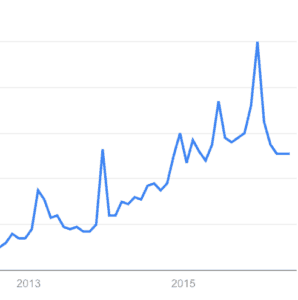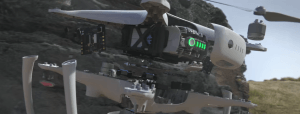Why Drones Have the Power to Sink GoPro
We here at Drone Lifestyle have been following the drone industry for over a year and a half now, and while this may not seem like a crazy long time, it feels more like a decade considering how this industry is evolving: just look at the growth of Google searches involving the keyword “drones” since since 2013.

Data from Google Trends tracking the frequency of the keyword “drones” since 2013.
When we first picked up a DJI Phantom back in 2013, it was pretty obvious this technology would soon change the world. We knew it, and so did GoPro. To directly get in on the action themselves GoPro attempted/is attempting to build their own drone… best of luck, GoPro!
As GoPro is finding out, drones are hard to build.

Drones require state-of-the-art components from many different engineering disciplines.
Quadcopters are basically bricks being suspended from mid air. Lacking all conventional aerodynamics, quadcopter drones are able to stay perfectly positioned — frozen in air — seemingly by magic. While it may not be magic in the fairy tale sense of the word, it is magic in a sense that quadcopters are capable of triangulating their position using data from satellites. Algorithms then take this real-time data and calculate how much lift each motor needs to create in order to stay level and controlled. Up, right, left, down. Constantly adjusting. Constantly running numbers… software working seamlessly with hardware in a revolutionary way.
This Just In – GoPro Chases Apple off a Bridge.
Although components of modern drone technology have been floating around for decades, mostly on the fringes of the world at places like Radio Shack, NASA, and Garmin, it wasn’t until DJI came along that these scattered pieces of hardware and software were combined in such a way that the world took notice. So much so that one of the most profitable companies in the world, Apple, began stocking its shelves with DJI quadcopters.
As a company very familiar with the amount of resources it takes to successfully blend hardware and software together, excellence recognizing excellence, Apple made a sound business decision: Instead of competing with DJI for the new opportunities opening up in the aerial photography market, Apple simply partnered with DJI and began profiting with rising company. It looked like (for a time at least) that GoPro would do the same.
GoPro saw a golden opportunity to partner with DJI, and rightly so. The GoPro brand recognition + DJI’s expertise could have meant big dollars on both sides. But as seems to be GoPro’s course of action lately, GoPro screwed it all up:
“Initially [GoPro and DJI] wanted to make a product together for GoPro to sell, but the negotiation never came to fruition,” DJI CEO Frank Wang told FORBES in a recent interview. They treated us like the original equipment manufacturers (OEMs). The deal came out to roughly this: GoPro would make two points of profit, and I’d make one point.”
Since DJI has earned itself nearly $8 billion evaluation, you get to walk on deals like that and flip the bird to competitors a fraction of your size (GoPro currently has a market cap of only $2 billion). GoPro however went undeterred. The maverick company was set on breaking into the drone photography fad, at whatever the cost.
But instead basically getting keys to a Porsche that you get to paint your name onto and call your own just in a matter of months, GoPro decided it would invent its own Porsche in basically the same frame. Best of luck.
Yo bro, what gives?
When GoPro’s maverick CEO, Nick Woodman, officially announced the gigantic undertaking of designing and manufacturing GoPro’s own drone, the reception wasn’t quite what the 39 year-old billionaire was expecting. Instead of a raucous uproar and epic backflips, the audience mustered a few cheers and meager applause. The audience at a technology conference in California could smell the desperation and recklessness of the decision.
Thanks to a mix of the fact that everybody now has a pretty good camera on their phone already, and the rest of the people who really wanted a GoPro in the first place already bought one (and even though Apple has accomplished the feat, it is notoriously difficult for most hardware companies to generate a decent turnover rate for new modes), GoPro shares were rapidly deteriorating, and something big had to be done to save the company.
In the short term, the announcement worked. It signaled a new direction of growth and diversification for the narrowly focused camera company. The day after this announcement, shares rose 6.5 percent. However, this short term growth would not be echoed in the coming months.
“Often imitated, but never replicated” – DJI
Fast forward nine months down the road, and there has been little word on the progress of Karma, GoPro’s quadcopter. Since the summer that talks fell through with DJI, GoPro’s stock has fallen from 57 to 17 dollars. Meanwhile tomorrow, Phantom 4’s from DJI will begin arriving on the doorsteps of customers eager to test out some of DJI’s most mind blowing features yet: obstacle avoidance and subject tracking.
Given the amount of time GoPro gave itself to release a drone, it would be incredible if GoPro was able to release a drone comparable in quality to that of a Phantom 2 for under a grand. And that wouldn’t be such a bad thing if it weren’t for these reasons:
- DJI is only focused on drones. As long as GoPro makes drones a side project, it will never catch up in this race.
- The aerial photography market feels like it is just about saturated and may be losing steam.
- DJI is looking to expand to into where the real money is at, commercial uses for drone technology, and while growing and learning in that market, will be able to snuff out competitors in markets like photography with ease.

There is actually very little separating the majority of enthusiast drones these days. They can all be reverse engineered and built in a factory. Technology wise little separates them, so companies will possibly just specialise more on application, or perhaps due to all the hype a lot of them will go bust and we just consolidate the industry a bit.
It’s true, Sash. Many of the products out there are starting to look a lot alike.